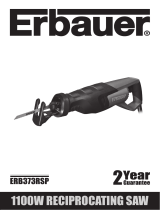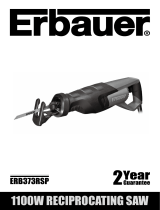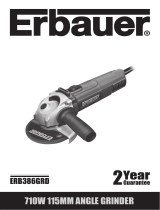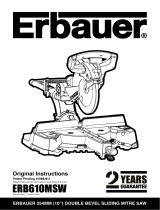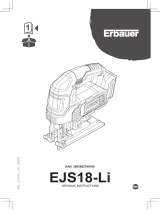Page is loading ...

710W JIGSAW
ERB389JSW

Original Instructions
(Version 2.0)

710W JIGSAW
GUARANTEE
This product carries a 2 year guarantee. If your product develops a fault within this
period, you should in the rst instance contact the retailer where the item was purchased.
This guarantee specically excludes losses caused due to:
- Fair wear and tear
- Misuse or abuse
- Lack of routine maintenance
- Failure of consumable items (such as batteries)
- Accidental damage
- Cosmetic damage
- Failure to follow manufacturer’s guidelines
- Loss of use of the goods
This guarantee does not affect your statutory rights. This guarantee is only valid in the UK.
For further technical advice, spare parts or repair service (outside of guarantee) please con-
tact the customer helpline number on 0345 607 6380.
Congratulations on your purchase of a quality power tool from Erbauer (UK) Ltd. This
product should give you reliable service but for your peace of mind this
power tool does carry a 2 year guarantee, the terms of which are detailed below.
If this product develops a fault within the guarantee period contact your retailer.
Please retain this handbook in case you need to refer to safety, care or guarantee
information in the future.

GENERAL POWER TOOL SAFETY WARNINGS
Warning! Read all safety warnings and all instructions.
Failure to follow the warnings and instructions may result in
electric shock, re and/or serious injury.
Save all warnings and instructions for future reference.
The term “power tool” in the warnings refers to your mains-operated
(corded) power tool or battery-operated (cordless) power tool.
1. Work area safety
a. Keep work area clean and well lit. Cluttered or dark areas
invite accidents.
b. Do not operate power tools in explosive atmospheres,
such as in the presence of ammable liquids, gases or dust.
Power tools create sparks which may ignite the dust or fumes.
c. Keep children and bystanders away while operating a
power tool. Distractions can cause you to lose control.
2. Electrical safety
a.Power tool plugs must match the outlet. Never modify the
plug in any way. Do not use any adapter plugs with earthed
(grounded) power tools. Unmodied plugs and matching outlets
will reduce risk of electric shock.
b. Avoid body contact with earthed or grounded surfaces,
such as pipes, radiators, ranges and refrigerators. There
is an increased risk of electric shock if your body is earthed or
grounded.
c. Do not expose power tools to rain or wet conditions. Water
entering a power tool will increase the risk of electric shock.
d. Do not abuse the cord. Never use the cord for carrying,
pulling or unplugging the power tool. Keep cord away from
heat, oil, sharp edges or moving parts. Damaged or entangled
cords increase the risk of electric shock.
e. When operating a power tool outdoors, use an extension
cord suitable for outdoor use. Use of a cord suitable for outdoor
use reduces the risk of electric shock.
f. If operating a power tool in a damp location is unavoidable,
use a residual current device (RCD) protected supply. Use of

710W JIGSAW
an RCD reduces the risk of electric shock.
3. Personal safety
a. Stay alert, watch what you are doing and use common
sense when operating a power tool. Do not use a power tool
while you are tired or under the inuence of drugs, alcohol
or medication. A moment of inattention while operating power
tools may result in serious personal injury.
b. Use personal protective equipment. Always wear eye
protection. Protective equipment such as dust mask, non-skid
safety shoes, hard hat, or hearing protection used for appropriate
conditions will reduce personal injuries.
c. Prevent unintentional starting. Ensure the switch is in
the off-position before connecting to power source and/or
battery pack, picking up or carrying the tool. Carrying power
tools with your nger on the switch or energising power tools that
have the switch on invites accidents.
d. Remove any adjusting key or wrench before turning the
power tool on.
A wrench or a key left attached to a rotating part of the power tool
may result in personal injury.
e. Do not overreach. Keep proper footing and balance
at all times. This enables better control of the power tool in
unexpected situations.
f. Dress properly. Do not wear loose clothing or jewellery.
Keep your hair, clothing and gloves away from moving parts.
Loose clothes, jewellery or long hair can be caught in moving
parts.
g. If devices are provided for the connection of dust
extraction and collection facilities, ensure these are
connected and properly used. Use of dust collection can
reduce dust-related hazards.
4. Power tool use and care
a. Do not force the power tool. Use the correct power tool for
your application. The correct power tool will do the job better and
safer at the rate for which it was designed.
b. Do not use the power tool if the switch does not turn it on

and off. Any power tool that cannot be controlled with the switch
is dangerous and must be repaired.
c. Disconnect the plug from the power source and/or
the battery pack from the power tool before making any
adjustments, changing accessories, or storing power tools.
Such preventive safety measures reduce the risk of starting the
power tool accidentally.
d. Store idle power tools out of the reach of children and
do not allow persons unfamiliar with the power tool or
these instructions to operate the power tool. Power tools are
dangerous in the hands of untrained users.
e. Maintain power tools. Check for misalignment or binding
of moving parts, breakage of parts and any other condition
that may affect the power tool’s operation. If damaged,
have the power tool repaired before use. Many accidents are
caused by poorly maintained power tools.
f. Keep cutting tools sharp and clean. Properly maintained
cutting tools with sharp cutting edges are less likely to bind and
are easier to control.
g. Use the power tool, accessories and tool bits etc. in
accordance with these instructions, taking into account the
working conditions and the work to be performed. Use of
the power tool for operations different from those intended could
result in a hazardous situation.
5. Service
a) Have your power tool serviced by a qualied repair
person using only identical replacement parts. This will
ensure that the safety of the power tool is maintained.
b) If the replacement of the supply cord is necessary, this
has to be done by the manufacturer or his agent in order to
avoid a safety hazard.

710W JIGSAW
ADDITIONAL SAFETY POINTS FOR YOUR JIGSAW
1. Always wear a dust mask.
2. Hold power tool by insulated gripping surfaces, when
performing an operation where the cutting accessory may
contact hidden wiring or its own cord. Cutting accessory
contacting a “live” wire may make exposed metal parts of the
power tool “live” and could give the operator an electric shock.
3. Use clamps or another practical way to secure and support
the workpiece to a stable platform. Holding the work by hand
or against your body leaves it unstable and may lead to loss of
control.
4. Always wear safety glasses or eye shields when using the
jig saw. Everyday eyeglasses have only impact-resistant
lenses; they are NOT safety glasses. Following this rule will
reduce the risk of serious personal injury.
5. Always wear hearing protection during extended periods
of operation. Following this rule will reduce the risk of serious
personal injury.
6. Keep your hands away from cutting area. Do not reach under
the material being cut because the nearness of the blade to
your hand is hidden from your sight.
7. Do not use dull or damaged blades. Bent blades can break
easily, or cause kickback.
8. Remove the plug from the socket before carrying out any
adjustment, servicing or maintenance.
9. Fully unwind cable drum extensions to avoid potential
overheating.
10. When an extension cable is required you must ensure it has
the correct ampere rating for your power tool and is in a safe
electrical condition.
11. Ensure your mains supply voltage is the same as indicated on
the rating plate.
12. Your tool is double insulated for additional protection against a
possible electrical insulation failure within the tool.
13. Always check walls, oors and ceilings to avoid hidden power
cables and pipes.
14. After long working period, external metal parts and accessories
could be hot.

15. Only withdraw the blade from the cut when the blade has been
stopped moving.
16. The pivoting blade foot must be held rmly against the material
being cut to reduce saw vibration, blade jumping and blade
breakage.
17. Before cutting, check the cutting line is free of nails, screws, etc.
18. If possible, ensure the work-piece is rmly clamped to prevent
movement.
19. Never stop the cutting blade by applying side pressure to the
blade.
Warning:
Some dust particles created by power sanding, sawing, grinding, drilling and
other construction jobs contain chemicals known to cause cancer, birth defects or
other reproductive harm. Some examples of these chemicals are:
• Lead from lead-based paints.
• Crystalline silica from bricks and cement and other masonry products.
• Arsenic and chromium from chemically treated lumber.
Your risk from these exposures varies, depending upon how often you do this type of work. To
reduce your exposure to these chemicals.
• Work in a well-ventilated area.
• Work with approved safety equipment, such as those dust masks that are specially
designed to lter microscopic particles.
VIBRATION
The European Physical Agents (Vibration) Directive has been brought in to help reduce
hand arm vibration syndrome injuries to power tool users. The directive requires power
tool manufacturers and suppliers to provide indicative vibration test results to enable users
to make informed decisions as to the period of time a power tool can be used safely on a
daily basis and the choice of tool.
Further Advice can be found at www.hse.gov.uk
Vibration total values (triax vector sum) determined according to EN 60745:
Cutting wood Vibration emission value a
h
=13.9m/s²
Uncertainty K = 1.5m/s²
Cutting sheet metal Vibration emission value a
h
=11.5m/s²
Uncertainty K = 1.5m/s²
The declared vibration emission value should be used as a minimum level and should be
used with the current guidance on vibration.
Calculating the actual period of the actual period off use can be difcult and the HSE
website has further information.

710W JIGSAW
The declared vibration emission been measured in accordance with a standardised test
stated above and may be used to compare one tool with another tool.
The declared vibration emission value may also be used in a preliminary assessment of
exposure.
Warning: The vibration emission value during actual use of the power tool can differ
from the declared value depending on the ways in which the tool is used dependant
on the following examples and other variations on how the tool is used:
How the tool is used and the materials being cut or drilled.
The tool being in good condition and well maintained
.
The use the correct accessory for the tool and ensuring it is sharp and in good condition.
The tightness of the grip on the handles.
And the tool is being used as intended by its design and these instructions.
While working with this power tool, hand/arm vibrations occur. Adopt the correct
working practices in order to reduce the exposure to vibration.
This tool may cause hand-arm vibration syndrome if its use is not adequately
managed.
Warning: Identify safety measures to protect the operator that are based on an
estimation of exposure in the actual conditions of use (taking account of all parts of
the operating cycle such as the times when the tool is switched off and when it is running
idle in addition to the trigger time).Note The use of other tools will reduce the users’ total
working period on this tool.
Helping to minimise your vibration exposure risk.
ALWAYS use sharp chisels, drills and blades
.
Maintain this tool in accordance with these instructions and keep well lubricated
(where appropriate)
.
Avoid using tools in temperatures of 10ºC or less
.
Plan your work schedule to spread any high vibration tool use across a number of days.
Health Surveillance
All employees should be part of an employer’s health surveillance scheme to help identity
any vibration related diseases at an early stage, prevent disease progression and help
employees stay in work.
Double insulation
The tool is double insulated. This means that all the external metal parts are electrically
insulated from the mains power supply. This is done by placing insulation barriers between
the electrical and mechanical components making it unnecessary for the tool to be
earthed.
Important note
Be sure the supply is the same as the voltage given on the rating plate. The tool is tted
with a two-core cable and plug.
Remove the mains plug from socket before carrying out, any adjustment or servicing
.

SYMBOLS
To reduce the risk of injury, user must read instruction manual
Warning
Double insulation
Wear ear protection Wear eye protection Wear dust mask
Waste electrical products should not be disposed of with household waste.
Please recycle where facilities exist. Check with your Local Authority
or retailer for recycling advice.
yyWxx Manufacturing date code; Year of manufacturing (20yy) and week of
manufacturing (Wxx);

710W JIGSAW
2
7
11
4
9
3
5
6
10
12
14
13
1
8

1. ON/OFF SWITCH
2. SWITCH LOCK-ON BUTTON
3. HAND GRIP AREAS
4. VARIABLE SPEED CONTROL
5. HEX KEY
6. DUST TUBE
7. BASE PLATE
8. ANGLE PLATE
9. PENDULUM ACTION CONTROL
10. ROLLER GUIDE
11. SAW BLADE
12. FINGER PROTECTION
13. TOOL-FREE BLADE HOLDER
14. WORK LIGHT
15. PARALLEL GUIDE (See Fig. 6-1, 6-2)

710W JIGSAW
TECHNICAL DATA
Voltage 230-240V~50Hz
Power input 710W
No load speed 800-2800/min
Stroke length 24mm
Bevel capacity 0~45°, L&R
Cutting capacity, max.
Wood 120mm
Aluminum 20mm
Steel 10mm
Protection class
/II
Machine weight 2.5kg
NOISE DATA
Sound pressure level: L
pA
: 93dB(A) K
PA
=3.0dB(A)
Sound power level: L
wA
: 104dB(A) K
WA
=3.0dB(A)
Wear ear protection when sound pressure is over 80dB(A)
ACCESSORIES
Parallel guide 1pc
Hex key 1pc
Dust tube 1pc
Wood cutting blade 2pcs
Aluminum cutting blade 2pcs
Metal cutting blade 2pcs

OPERATION INSTRUCTIONS
NOTE: Before using the tool, read the
instruction book carefully.
INTENDED USE:
The machine is intended for sawing wood, plastic,
metal and building materials while resting rmly on
the workpiece. It is suitable for straight and curved
cuts with bevel angles to 45°. The saw blade
recommendations are to be observed.
1.ON/OFF SWITCH
Depress to start and release to stop your tool.
2. SWITCH LOCK-ON BUTTON
Depress on/off switch (1) then lock-on button (2)
(See Fig.1), release on/off switch rst then lock-on
button second. Your switch is now locked on for
continuous use. To switch off your tool just depress
and release on/off switch.
3. VARIABLE SPEED CONTROL
Adjust the thumb-wheel to increase or decrease
the speed (See Fig.2) according to the material,
material thickness and blade specication to be
used (also possible during no load operation). See
Chart 1 for general guidance on speed selection.
Avoid prolonged use at very low speed as this may
damage your jigsaw’s motor.
Chart 1
Material Speed setting
Wood 5-6
Metal 3-4
Aluminum 3-5
PVC 3-4
Ceramic 3-5
4. HAND GRIP AREAS
Always ensure you maintain a rm grip whilst
operating your jigsaw.
5. BLADE FITTING(See Fig.3, 4, 5)
You can only use the blade type shown in Fig.3.
Fig 1
Fig 2
Fig 4
1 2
4
13
10
a
b
15
1 2
4
13
10
a
b
15
Fig 3
1 2
4
13
10
a
b
15
1 2
4
13
10
a
b
15

710W JIGSAW
To open the blade holder (13) rotate the ring
anti-clockwise (Jigsaw upside down) and hold in
position (See Fig.4). Then fully insert the blade
into the blade holder slot with blade teeth facing
forward and release the ring, which will self rotate
and clamp over the top of the blade. Push the
blade into the blade holder again to ensure it is
locked in position. Ensure the edge of the blade
is located in the groove of the blade guide (See
Fig.5). To remove a blade, holds the blade and
rotate the blade holder ring anti-clockwise then lift
out the blade (blade could be spring ejected).
Warning: Blade teeth are very sharp. For
best cutting results ensure you use a blade
suited to the material and cut quality you need.
6. MOUNTING PARALLEL GUIDE
(See Fig.6-1, 6-2.)
First slide the parallel guide clamp (a) and locking
knob (b) onto the parallel guide (15). Then slide
the parallel guide arm through both parallel guide
xtures and place the clamp (a) on the xture.
Tighten the locking knob (b) to achieve the
required cutting distance. The parallel guide can
be mounted in two positions as shown in F6-1 and
F6-2.
7. ROLLER GUIDE
Ensure the blade is located and runs smoothly in
the groove (See Fig.5) otherwise the pendulum
function will not work correctly and the blade will
not be supported during cutting.
8. PENDULUM ACTION CONTROL (See Fig.7)
The pendulum action varies the forward cutting
angle of the blade for increased cutting efciency.
This can also be adjusted during no load running.
Refer to the chart 2 for more details. Do not use
excessive blade force when cutting with the
pendulum action. The blade cuts on the upward
stroke only.
Chart 2
0 Thin materials. Fine cuts.
Tight curves.
Fig 5
1 2
4
13
10
a
b
15
Fig 6-1
Fig 6-2
Fig 7
1 2
4
13
10
a
b
15
1 2
4
13
10
a
b
15
9
8
8
7
6

I Hard materials, (e.g. steel &
chipboard)
II Thick materials ( e.g. wood )
& plastic
III Fast cuts (e.g. softwood).
Cutting in the
9. BASE PLATE
Adjusting the angle of the base plate (7) enables
bevel cutting. The base plate must always be held
rmly against the materials being cut to reduce
saw vibration, blade jumping or blade breakage.
10. BASE PLATE ANGLE ADJUSTMENT
Use a Hex Key (5). Loosen the bolts securing the
base plate (See Fig.8). For preset angles rotate so
the lines of the angle on the base plate and angle
plate (8) superposition at the desired angle (0, 15,
30, 45) (See Fig.9). For other mitre angles, rotate
to your desired angle (use a protractor scale).
Following one of the above procedures, hold the
base plate in position and rmly tighten the bolts to
clamp the base plate at that angle. Finally, check the
angle and ensure the base plate is rmly clamped.
The angle markings on the base plate are accurate
for most general purposes but it is recommended
for accurate work to set the angle with a protractor
a n d m a k e a t e s t c u t o n o t h e r m a t e r i a l .
11. DUST TUBE (See Fig.10)
Mount the dust tube (6) into the opening of the
base plate (7). Make sure that the plastic tip
of the vacuum connection engages into the
corresponding opening on the housing as shown in
the gure.
12. PROTECTION FINGER WIRE
The nger wire is located in front of the blade
holder. Whilst working, it will help prevent
accidental contact with moving blade.
13. DUST BLOWER AIR HOLE
This is a small aperture located underneath the
housing just behind the blade guide. Ensure this is
kept clean to allow the air ow to continually blow
Fig 8
Fig 9
Fig 10
9
8
8
7
6
9
8
8
7
6
9
8
8
7
6

710W JIGSAW
dust away from the cutting area.
15. WORK LIGHT
Press the on/off switch (1), the work light(14)will
illuminate. Release the on/off switch to turn off the
work light.
Caution: Do not look into the strong light or
see the source of light directly.
WORKING HINTS FOR YOUR JIG SAW
If your jig saw becomes too hot, especially when
used at low speed, set the speed to maximum
and run no Load for 2-3 minutes to cool the motor.
Avoid prolonged usage at very low speeds.
GENERAL
Always use a blade suited to the material and
material thickness to be cut. Always ensure the
work–piece is rmly held or clamped to prevent
movement. For easier control, use low speed to
start cutting, then increase to correct speed.
Any movement of the material may affect the
quality of the cut. The blade cuts on the upward
stroke and may chip the uppermost surface or face
of the work piece. Ensure your uppermost surface
is a non-visible surface when your work is nished.
CUTTING LAMINATES
Use a ne tooth blade when cutting most laminates
and thin wood materials. To reduce edge chipping,
clamp pieces of waste wood at both ends on both
sides and cut through the waste wood during
cutting.
CIRCLE CUTTING
Do not use the pendulum action when cutting tight
circles or angles
PLUNGE SAWING
Plunge cutting may be used only on soft materials
such as wood, aerated concrete, gypsum plaster
boards, etc.!
Use only short saw blades.
Place the front edge of the base plate on the

workpiece and switch on. Press the machine rmly
against the workpiece and plunge the saw blade
slowly into the workpiece.
As soon as the complete surface of the base plate
rests on the work piece, continue to saw along the
cutting line. (See Fig.11, 12)
METAL CUTTING
Use a ner tooth blade for ferrous metals and a
coarse tooth blade for non-ferrous metals. When
cutting thin sheet metals always clamp wood on
both sides of the sheet to reduce vibration or
tearing of the sheet metal. Both wood and sheet
metal must be cut. Do not force the cutting blade
when cutting thin metal or sheet steel as they
are harder materials and will take longer to cut.
Excessive blade force may reduce the life of the
blade or damage the motor. To reduce heat during
metal cutting, add a little lubricant along the cutting
line.
MAINTENANCE
Remove the plug from the socket before carrying
out any adjustment, servicing or maintenance.
Your power tool requires no additional lubrication
or maintenance. There are no user serviceable
parts in your power tool. Never use water or
chemical cleaners to clean your power tool. Wipe
clean with a dry cloth. Always store your power
tool in a dry place. Keep the motor ventilation
slots clean. Keep all working controls free of
dust. Occasionally you may see sparks through
the ventilation slots. This is normal and will not
damage your power tool.
If the supply cord is damaged, it must be replaced
by the manufacturer, its service agent or similarly
qualied persons in order to avoid a hazard.
Fig 12
9
8
8
7
6
Fig 11
9
8
8
7
6

710W JIGSAW
ENVIRONMENTAL PROTECTION
Waste electrical products should not be
disposed of with household waste. Please
recycle where facilities exist. Check with your
Local Authority or retailer for recycling advice.For
further information visit www.recycle-more.co.uk
PLUG REPLACEMENT
(UK & IRELAND ONLY)
If you need to replace the tted plug then follow
the instructions below.
IMPORTANT
The wires in the mains lead are colored in
accordance with the following code:
BLUE =NEUTRAL
Brown = Live
As the colors of the wires in the mains lead of this
appliance may not correspond with the colored
markings identifying the terminals in your plug,
proceed as follows. The wire which is colored blue
must be connected to the terminal which is marked
with N. The wire which is colored brown must be
connected to the terminal which is marked with L.
Warning:
Never connect live or neutral wires to the
earth terminal of the plug. Only t an approved
13AMP BS1363/A plug and the correct rated
fuse.
Note: If a moulded plug is tted and has to be
removed take great care in disposing of the plug
and severed cable, it must be destroyed to prevent
engaging into a socket.
13 Amp fuse approved
to BS1362
Connect
Blue to N
(neutral)
Outer sleeve
rmly clamped
Brown L(live)
Cable grip

DECLARATION OF CONFORMITY
We, Importer
Erbauer (UK) Ltd BA22 8RT
Declare that the product
Description: 710W JIGSAW
Model: ERB389JSW
Complies with the following Directives,
EC Machinery Directive 2006/42/EC
EC Low Voltage Directive 2006/95/EC
EC Electromagnetic Compatibility Directive 2004/108/EC
Restrictions of the Use of Certain Hazardous Substances in Electrical and Electronic Equipment 2011/65/EU
Waste Electrical and Electronic Equipment (WEEE) 2012/19/EU
Standards and technical specications referred to:
EN 55014-1
EN 55014-2
EN 61000-3-2
EN 61000-3-3
EN 60745-1
EN 60745-2-11
Authorised Signatory and technical le holder
Date: 10/02/15
Signature:
Name / title: Peter Harries / Quality Manager
Erbauer (UK) Ltd. Trade House, Mead Avenue, BA22 8RT
/
